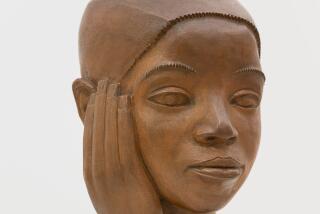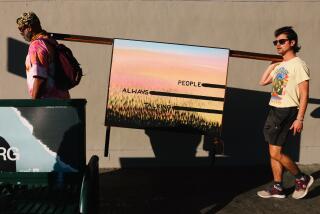Steve Martin-curated Lawren Harris exhibition shines light on landscapes physical and metaphorical
- Share via
Painter Lawren Harris (1885-1970) is a national icon in Canada, but not widely known outside his home country. At the UCLA Hammer Museum, a modest show of “greatest hits” from the dozen years when his wilderness landscape theme matured — and before he abandoned it for total abstraction — seeks to widen his appreciation in the United States.
Unfortunately, the paintings just aren’t up to it. In an introductory wall text, the museum doesn’t help matters by situating fairly conventional Symbolist landscapes in the company of major pictorial innovators like Americans Arthur Dove and Marsden Hartley. Enthusiasm for accomplished, perfectly pleasant Modern paintings is stretched to the breaking point.
It isn’t that Harris is bad. He’s good — just not that good.
SIGN UP for the free Essential Arts & Culture newsletter >>
“The Idea of North: The Paintings of Lawren Harris” was organized by guest curator Steve Martin, the well-known actor and entertainer and a collector of Harris’ paintings. (None of Martin’s Harris works are said to be in the show, but the museum erred in inviting a collector with a vested interest to be curator of an educational endeavor. Plenty of scholars are available.)
It includes 16 large oils on canvas and 15 small studies on board, all made between 1922 and about 1934.
Handsome and self-assured, they display an enviable color sense. A mostly jewel-toned palette rendered in flat, broad, dense strokes of paint is dominated by shades of sapphire, amethyst and turquoise set off by neutrals. The result is sleek, wintry landscapes of fairly luminous, snow-covered mountain peaks, ballooning clouds and stern shafts of streaming sunlight.
Harris exposes remote scenes of the Canadian wilderness to an idealized formal structure, animating immobile mountains through rhythmic patterns of repetition.
An Art Deco machine-style with geometric underpinnings is applied to nature’s monumental solidity, the rhythmic forms and luxurious colors transforming massive landforms into shifting, ocean-like swells. Earth as a living, evolving, quietly majestic yet churning entity is evoked.
Civilization is spurned — or at least not pictured as an avenue for enlightenment. People don’t turn up in Harris’ art.
Only once in the show does a building appear, and even then it’s an abandoned ice-house whose tilted, subtly curving form is subjected to the visual pressures of nature that surround it.
Throughout, the only real evidence of humanity is the paintings themselves; they are visibly crafted as an artist’s considered communication with the natural world.
Harris embraced theosophy, the esoteric system of comprehending divinity. Theosophy had a widespread impact on European and American artists by the start of the 20th century. (At 19, Harris began nearly four years of study in Berlin, then headed off to Damascus and Cairo.)
Sometimes his rising mountain peaks suggest pipe organs housed inside nature’s radiant cathedral, their central thrust up into a pristine sky an escalating visual swell meant to pierce the infinite.
A tall, phallic tree stump is set against a voluptuous landscape at the center of “North Shore, Lake Superior,” his most well-known painting. It does reflect a traditional faith in the blunt fact of death as inseparable from abundant life. But it is also a rather too-obvious metaphor.
Harris, heir to an Ontario industrial fortune, used his wealth and social standing to establish a distinctly national school of Canadian painting.
Founder and leading artist of what he dubbed the Group of Seven, he co-financed construction of a 1914 Toronto studio building for low-cost working and meeting space, subsidized rail trips for artists into the wilderness and sponsored exhibitions.
Why forge a national school? Following World War I, the bloodiest conflict in Canadian history, the nation was becoming steadily less deferential to Great Britain. Landscape offered a common artistic subject for nationalist aspirations.
In Europe and the Americas, the landscape motif emerged as a force in the late 18th and early 19th century, along with the socio-political structure of the nation-state. Like John Constable in England, José María Velasco in Mexico or Albert Bierstadt in the United States, Canada had Cornelius Krieghoff or Lucius O’Brien, their landscapes emblematic of a treasured “homeland.” Harris modernized the long-established motif.
As did many, many other North American painters, often stylistically inspired — directly or indirectly — by the hugely influential teaching and writing of painter Arthur Wesley Dow. Symbolist artists, rather than adopt naturalism and narrative, embraced the subjective representation of an idea.
So did Harris. His well-crafted Canadian landscapes represent a familiar artistic benchmark set for the early 20th century.
UCLA Hammer Museum, 10899 Wilshire Blvd., Westwood, (310) 443-7000, through Jan. 24. Closed Mondays. www.ucla.hammer.edu
ALSO:
Getty acquires first photos ever taken of ancient ruins ISIS recently destroyed
More to Read
The biggest entertainment stories
Get our big stories about Hollywood, film, television, music, arts, culture and more right in your inbox as soon as they publish.
You may occasionally receive promotional content from the Los Angeles Times.











